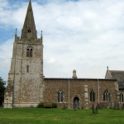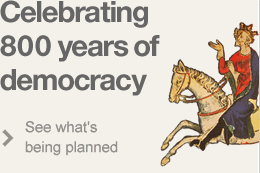
Pre Magna Carta | Post Magna Carta | Restoring Royal Authority | 2nd Barons’ War
Dissatisfaction with Henry III’s methods of government led to the 1258 Provisions of Oxford which sought to establish royal accountability to a council of barons. Henry III reneged on the Provisions, leading to war between the royal faction and the leader of the barons, Simon de Montfort, who was victorious in 1264. In January 1265 de Montfort called a Parliament which is seen as the earliest forerunner of the modern Parliament because it included representatives from counties, cities and towns. In 1266 he was slain at Evesham.
1264 Northampton (siege and battle) | Northamptonshire
 The Battle of Northampton was fought between King Henry and his son Prince Edward (the future King Edward I) and Simon de Montfort’s supporters led by his son Simon. Whilst, Henry attacked the town from the south, Edward led troops to break in through the northern wall on 5 April. The town was sacked and the castle surrendered the next day. In 1238, after an affray between alumni and followers of the Papal Legate, scholars from Oxford and Cambridge moved to Northampton. As the students supported de Montfort, Henry decreed “…no University should ever after be attempted to be removed to, or founded, in Northampton”.
The Battle of Northampton was fought between King Henry and his son Prince Edward (the future King Edward I) and Simon de Montfort’s supporters led by his son Simon. Whilst, Henry attacked the town from the south, Edward led troops to break in through the northern wall on 5 April. The town was sacked and the castle surrendered the next day. In 1238, after an affray between alumni and followers of the Papal Legate, scholars from Oxford and Cambridge moved to Northampton. As the students supported de Montfort, Henry decreed “…no University should ever after be attempted to be removed to, or founded, in Northampton”.
1264 Rochester Castle (siege) | Kent
 During the 2nd Barons’ War (1264–1267), Rochester Castle was besieged for the third time in its history. Roger de Leybourne, the royal constable, held Rochester in support of Henry III. Rebel armies led by Simon de Montfort and Gilbert de Clare entered the city and set about trying to capture the castle. Although unsuccessful the attack drew the royalist forces south where they were defeated at Lewes.
During the 2nd Barons’ War (1264–1267), Rochester Castle was besieged for the third time in its history. Roger de Leybourne, the royal constable, held Rochester in support of Henry III. Rebel armies led by Simon de Montfort and Gilbert de Clare entered the city and set about trying to capture the castle. Although unsuccessful the attack drew the royalist forces south where they were defeated at Lewes.
1264 Lewes (battle) | East Sussex
 The Battle of Lewes was the first of two main battles of the 2nd Barons’ War, which took place on 14 May 1264. It marked the highest point of the career of Simon de Montfort, 6th Earl of Leicester, and made him ‘uncrowned King of England’. He also called the first parliament in England. Henry III left the safety of Lewes Castle to engage the barons in battle and was only initially successful. His son Prince Edward led a successful cavalry charge and scattered the London foot militia; but his knights proved impossible to rally to return to the fray. This allowed the Montfortians to overwhelm the rest of the royalist army and capture the king. The castle in the town is still in excellent repair and provides a magnificent view of the surrounding countryside from its keep. As at Lincoln, there is a twin motte although this no longer retains its fortifications.
The Battle of Lewes was the first of two main battles of the 2nd Barons’ War, which took place on 14 May 1264. It marked the highest point of the career of Simon de Montfort, 6th Earl of Leicester, and made him ‘uncrowned King of England’. He also called the first parliament in England. Henry III left the safety of Lewes Castle to engage the barons in battle and was only initially successful. His son Prince Edward led a successful cavalry charge and scattered the London foot militia; but his knights proved impossible to rally to return to the fray. This allowed the Montfortians to overwhelm the rest of the royalist army and capture the king. The castle in the town is still in excellent repair and provides a magnificent view of the surrounding countryside from its keep. As at Lincoln, there is a twin motte although this no longer retains its fortifications.
1264 Barham Down (muster) | Kent
 Faced with a threat from abroad led by Henry III’s queen, Simon de Montfort declared that an army be drawn from every town, city and village to be assembled as a muster on Barham Down, near Canterbury ‘against the foreigners’. Barham Downs include some wooded areas north-west of the village centre. The assembled company must have been an impressive sight, and it was judged at the time as a ‘huge army’. This large militia was not to be tested in action as contrary winds kept the invasion force at bay.
Faced with a threat from abroad led by Henry III’s queen, Simon de Montfort declared that an army be drawn from every town, city and village to be assembled as a muster on Barham Down, near Canterbury ‘against the foreigners’. Barham Downs include some wooded areas north-west of the village centre. The assembled company must have been an impressive sight, and it was judged at the time as a ‘huge army’. This large militia was not to be tested in action as contrary winds kept the invasion force at bay.
1264-5 Pevensey Castle (siege) | East Sussex
 Pevensey Castle was of key strategic importance and a formidable fortress on the south coast of England. Simon de Montfort scored his notable victory at the Battle of Lewes, after which the defeated royalist army fled to Pevensey. They were pursued by de Montfort’s forces, but the garrison refused an invitation to surrender and had to endure a year of siege. The garrison was still able to raid the surrounding countryside undetected. They secured supplies of food despite the ditches that had been dug by de Montfort’s men, also obtaining food and weapons by sea in December 1264. The siege proved costly and ineffective, and was eventually lifted in July 1265. Originally a Roman ‘Saxon Shore’ fort, the keep and inner bailey built within it are still in reasonable repair. Owing to land reclamation, the site is now some way distant from the sea, but it overlooks Pevensey Bay, where William, Duke of Normandy beached his fleet in 1066.
Pevensey Castle was of key strategic importance and a formidable fortress on the south coast of England. Simon de Montfort scored his notable victory at the Battle of Lewes, after which the defeated royalist army fled to Pevensey. They were pursued by de Montfort’s forces, but the garrison refused an invitation to surrender and had to endure a year of siege. The garrison was still able to raid the surrounding countryside undetected. They secured supplies of food despite the ditches that had been dug by de Montfort’s men, also obtaining food and weapons by sea in December 1264. The siege proved costly and ineffective, and was eventually lifted in July 1265. Originally a Roman ‘Saxon Shore’ fort, the keep and inner bailey built within it are still in reasonable repair. Owing to land reclamation, the site is now some way distant from the sea, but it overlooks Pevensey Bay, where William, Duke of Normandy beached his fleet in 1066.
1265 Evesham (battle) | Worcestershire
 The Battle of Evesham in August 1265 was the second of two major battles of the 2nd Barons’ War. It was a victory of Prince Edward, who led an 8,000-strong army of Henry III against 6,000 men of Simon de Montfort, and the beginning of the end of the rebellion. It was a massacre as de Montfort’s army was trapped in a bend of the river and the earl was killed along with many of his supporters, and his body disfigured.
The Battle of Evesham in August 1265 was the second of two major battles of the 2nd Barons’ War. It was a victory of Prince Edward, who led an 8,000-strong army of Henry III against 6,000 men of Simon de Montfort, and the beginning of the end of the rebellion. It was a massacre as de Montfort’s army was trapped in a bend of the river and the earl was killed along with many of his supporters, and his body disfigured.
1265 Peatling Magna | Leicestershire
 The happenings in early August at the south Leicestershire village of Peatling Magna took place just after the death of Simon de Montfort and the crushing of the Barons’ Revolt. The peasants suddenly saw the meaning of Magna Carta and rose up. Michael Wood in ‘In Search of England’ describes these extraordinary events. The king’s men led by Peter de Nevill came into the village fully armed. The peasants told them to leave as the soldiers were acting against the ‘Community of the Realm’. This is the first time peasants are recorded as speaking, and they talked of the communitas regni. In the resulting fracas, the men had to take refuge in the church, while the women of the village came out, worried their houses would be burned, and found a compromise. How simple rural peasants talked of and understood such concepts remains perplexing.
The happenings in early August at the south Leicestershire village of Peatling Magna took place just after the death of Simon de Montfort and the crushing of the Barons’ Revolt. The peasants suddenly saw the meaning of Magna Carta and rose up. Michael Wood in ‘In Search of England’ describes these extraordinary events. The king’s men led by Peter de Nevill came into the village fully armed. The peasants told them to leave as the soldiers were acting against the ‘Community of the Realm’. This is the first time peasants are recorded as speaking, and they talked of the communitas regni. In the resulting fracas, the men had to take refuge in the church, while the women of the village came out, worried their houses would be burned, and found a compromise. How simple rural peasants talked of and understood such concepts remains perplexing.
1266 Winchelsea | East Sussex
 After Evesham, Simon de Montfort jnr managed to reach the Cinque Ports, from where he tried in vain to organise an invasion from France. He was pursued by Prince Edward to Winchelsea, which was their last stronghold on the south coast, and after a combined land and sea assault, the town finally fell to the royal army.
After Evesham, Simon de Montfort jnr managed to reach the Cinque Ports, from where he tried in vain to organise an invasion from France. He was pursued by Prince Edward to Winchelsea, which was their last stronghold on the south coast, and after a combined land and sea assault, the town finally fell to the royal army.
1266 Isle of Axholme (siege) | North Lincolnshire
 After Evesham, the rebels also sought refuge in the Fens. Prince Edward with the shire levies of Nottinghamshire and Derbyshire laid siege and after throwing pontoons across the wetlands, the rebels surrendered. Baldwin Wake escaped the fighting and joined other disinherited barons at the Isle of Axholme before surrendering to Prince Edward.
After Evesham, the rebels also sought refuge in the Fens. Prince Edward with the shire levies of Nottinghamshire and Derbyshire laid siege and after throwing pontoons across the wetlands, the rebels surrendered. Baldwin Wake escaped the fighting and joined other disinherited barons at the Isle of Axholme before surrendering to Prince Edward.
1266 Chesterfield | Derbyshire
 On 15th May 1266 a royal army, led by Henry of Almain, nephew of Henry III, defeated some of the remaining rebels, allied to Simon de Montfort. This was the Battle of Chesterfield. The fierce battle was one of the final conflicts of the 2nd Barons’ War and led to the capture of Robert de Ferrers, Earl of Derby. Chronicles mention the use of covered wagons by the attackers and the fact that the Earl was suffering from gout. It was said that during the fighting, the Men of Brampton retreated to that part of the churchyard wall which it was their duty to maintain in normal times, and they refused to give way. A huge battle was waged through the streets of the town of Chesterfield, largely after dark, and lit only by the glow of burning buildings.
On 15th May 1266 a royal army, led by Henry of Almain, nephew of Henry III, defeated some of the remaining rebels, allied to Simon de Montfort. This was the Battle of Chesterfield. The fierce battle was one of the final conflicts of the 2nd Barons’ War and led to the capture of Robert de Ferrers, Earl of Derby. Chronicles mention the use of covered wagons by the attackers and the fact that the Earl was suffering from gout. It was said that during the fighting, the Men of Brampton retreated to that part of the churchyard wall which it was their duty to maintain in normal times, and they refused to give way. A huge battle was waged through the streets of the town of Chesterfield, largely after dark, and lit only by the glow of burning buildings.
1266 Kenilworth Castle (siege) – Warwickshire
 Although Simon de Montfort died at Evesham, his ideals of reform did not. Those remaining loyal to de Montfort entered and occupied Kenilworth Castle. King John had lavished money on Kenilworth, turning it into one of his largest castles. John ceded the castle to the barons as part of the guarantee of the Magna Carta, before it reverted to royal control in the reign of his son, Henry III. The rebels had fled Evesham fearing for their lives. So began one of the longest sieges in English history. From May to December 1266 the full might of the crown was turned on the insurgents. The position of the reformers became hopeless and they capitulated. The Dictum de Kenilworth, a legal pronouncement intended to restore royal authority, allowed for rehabilitation, and some rebels reclaimed their lands for a fine. This huge, red sandstone castle is now a ruin, but still provides an impression of why it proved so difficult to re-capture.
Although Simon de Montfort died at Evesham, his ideals of reform did not. Those remaining loyal to de Montfort entered and occupied Kenilworth Castle. King John had lavished money on Kenilworth, turning it into one of his largest castles. John ceded the castle to the barons as part of the guarantee of the Magna Carta, before it reverted to royal control in the reign of his son, Henry III. The rebels had fled Evesham fearing for their lives. So began one of the longest sieges in English history. From May to December 1266 the full might of the crown was turned on the insurgents. The position of the reformers became hopeless and they capitulated. The Dictum de Kenilworth, a legal pronouncement intended to restore royal authority, allowed for rehabilitation, and some rebels reclaimed their lands for a fine. This huge, red sandstone castle is now a ruin, but still provides an impression of why it proved so difficult to re-capture.
1267 Ely Castle (siege) – Cambridgeshire
 Evesham proved a decisive victory for the royal forces and Ely with its fortifications was also captured by Prince Edward. It had become a refuge for the resistance, though it crumbled as many nobles, including Earl Gilbert of Gloucester were re-admitted to royal favour. At Ely Castle, his siege tactics showed his plain superiority over the renegades, and he kindly offered them the peace terms of the Dictum de Kenilworth. Their acceptance of this in July 1267 finally brought lasting peace, two years after Evesham.
Evesham proved a decisive victory for the royal forces and Ely with its fortifications was also captured by Prince Edward. It had become a refuge for the resistance, though it crumbled as many nobles, including Earl Gilbert of Gloucester were re-admitted to royal favour. At Ely Castle, his siege tactics showed his plain superiority over the renegades, and he kindly offered them the peace terms of the Dictum de Kenilworth. Their acceptance of this in July 1267 finally brought lasting peace, two years after Evesham.
Featured Article
Introduction – Runnymede and all that. Winston Churchill described the Magna Carta as “the foundation of principles and systems of government of which neither King John or his nobles dreamed”. Now in Politics we’re used to the law of unintended consequences...
Read on...Recent Articles
- Magna Carta's American Adventure
- 800th anniversary of Bristol...
- Bristol 800 concert and...
- Emancipation and Magna Carta
- Terrorism and Tolerance -...
- Magna Carta
- Magna Carta Benches mark...
- ABA Magna Carta Memorial...
Stay updated
If you would like to keep informed about the work of the Magna Carta Trust and our partners, please sign up to the newsletter below.
Become a Supporter
There are a number of significant supporter opportunities. Register your interest early to ensure the widest range of options.
Find out more




